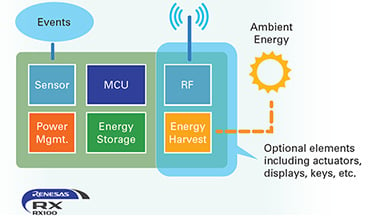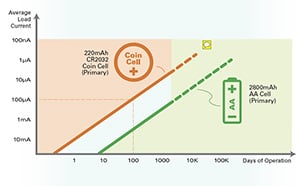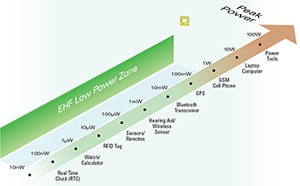Energy Harvesting in the embedded space is evolving rapidly to meet the requirement for low power consumption in Internet of Things (IoT) devices. Harvesting energy from the environment enables more efficient energy management, while allowing your battery to operate for years without a replacement. Energy harvesting is environmentally friendly, while also extending battery life and product reliability. However, designing with energy harvesting adds new design challenges. If an off-the-shelf primary cell battery meets your product requirements then you should use it, as it will be less expensive and easier to design. But if your product must operate for long periods of time without battery changes, then energy harvesting is an excellent option. Renesas' RX111 32-bit microcontroller (MCU) is ideally configured for energy harvesting applications and our energy harvesting solutions can meet your design requirements.
What is Energy Harvesting?
- Collecting ambient energy to power a load
- Energy can be collected from solar, thermal, vibration, RF, or other sources
- In portable devices, the harvester scale is small, with collection fluxes measured in μW to mW
- Low-power design techniques are paramount
- Selection of processor, power management IC, battery, and harvester are critical
Why is Energy Harvesting Used?
- AC power is not readily available
- Can't afford to change batteries due to high labor costs
- Accessibility or logistical challenges increase costs, usually in commercial applications
- Traditional battery solutions are too big or heavy
- UAVs, wearables, remote sensor nodes
- Eliminate disposable battery waste
- Europe is legislating to encourage alternatives that are less polluting than primary batteries
- Increase product lifetime
- Increase product reliability
- Application is a deeply embedded or implanted device that requires costly or dangerous battery replacement procedures

Typical Low Power Sensor Product
Factors to Consider
- Power budget
- Peak current
- Quiescent current
- Energy source
- Energy harvester
- Energy balance (Ein vs. Eout)
- Energy storage
- Power management
- Operating temperature
- Controller requirements
- Sensor specifications
- Wireless requirements
- Lifetime cost of ownership

Energy Harvesting Extends Product Lifetime
- Ambient energy is energy available from the environment.
- Light, heat, vibration, fluid flow, gas flow, RF, force, and rotation are just a few of the possible sources of energy
- Harvesting energy from the environment doesn't cost anything and as long as the harvesting subsystem remains active, the product can operate for many years without the need for battery changes.
- If your product needs to operate without battery changes and it cannot be recharged using AC mains and primary batteries won't power the product for its lifetime, then energy harvesting is a good candidate for your design.

Application Peak Power Levels
- Energy harvesting has the following important advantages over alternative solutions:
- Environmentally friendly (no replacement batteries in landfill)
- Product powered for life
- For commercial applications, avoid costly maintenance calls to replace batteries
- For infrastructure applications, set it and forget it
As mentioned above, the RX111 32-bit MCU is ideally configured for Energy Harvesting applications.
Renesas also offers the YRPBRX111 Evaluation Board for RX111 which provides a unique and cost-effective evaluation platform designed to facilitate the evaluation of the RX111 MCUs in a wide variety of applications that require operation at very low power levels with high levels of performance.
